Keeping cool while travelling: choose the right cool box!
11 September, 2021
Whether you have a long journey ahead, a day at the beach or are going camping in a tent for three weeks, a refreshing drink during your holiday is always a good idea. Cold drinks as well as food stay good for a longer period if you store it at the right temperature. But what is the best way to keep your food and drink cold? And which cool box should campers put on their essential list? This article gives you recommendations for cool boxes for every type of holiday.
- What kind of cool boxes are there?
- A cool box for en route
- A cool box for a day out
- A cool box for in the tent or trailer tent
- A cool box for in the caravan or motorhome
- More tips for keeping food and drinks cool at the campsite
Cool boxes: which types are there?
Before looking at the various cooling situations, it is good to know that cool boxes can be categorised roughly into four different types: the absorption cool box, the compression cool box, the thermoelectric cool box and the passive cool box. An intermediate form is the hybrid cool box. Which cool box is the best for at the campsite depends on your demands. Do you want a cool box that operates on a power supply or one that does not need plugging in? Is it important that the cool box is silent? And what are you willing to pay for it? Because there are inexpensive cool boxes as well as more expensive models.
The handy chart below lists the most important advantages and disadvantages per type. This can help you decide which cool box would be the best for you.
A cool box for en route
If you are going on holiday and have a long journey ahead of you, it is nice to take your own food along. You could choose a passive cool box but a car cool box offers more advantages. This type exists in a compression variant or an absorption variant. The 12-volt connection means you can plug this cool box in your car’s (cigarette) socket. Cooling elements are not necessary, giving you more room in your cool box for food and drink. Most car cool boxes also have a standard plug, allowing you to use it in your tent as well.
A cool box for a day out
While on holiday, you might like to take a trip to the beach or elsewhere, for example, an amusement park. Taking a heavy, electric cool box is not practical in this case and a passive cool box will suffice. Another possibility would be a cooling backpack or cool bag. In both cases, cooling elements are required to keep food and drink cool. The advantages of both the passive cool box and the cool bag are that they provide sufficient cooling for a shorter period and are considerably less heavy.
Cooling tip 1: It is handy to take along frozen drinks, water in particular, in the cool bag. Rolls can be buttered ahead of time, put in the freezer and taken along frozen. The rolls thaw as the day progresses and you can enjoy a fresh lunch!

A cool box is ideal for storing and transporting food and drink for a picnic!
A cool box for in the tent or trailer tent
If you are travelling with a tent or trailer tent, you may decide to choose a passive cool box with cooling elements. One that works on electricity is even better. You then have two options: an absorption cool box or a compression cool box. If you are going to a campsite in a hot country, it is best to choose a compression cool box even though it makes more noise. This type of cool box is also necessary in a tent, where the temperatures can reach more than thirty degrees. However, for a campsite at a holiday destination that is less hot, an absorption cool box should be just fine.
Cooling tip 2: The average cool box may be too small for an entire family. It is always a good idea to take a bucket along on holiday. Beer, wine and tins can be kept cool in a bucket of ice-cold water.
A cool box for in the caravan or motorhome
If you are going on holiday in a caravan or motorhome, it most likely has a fridge. This is by far the most practical way to keep your food and drinks cold. A caravan can be connected to the battery of the car while driving, which means that the fridge remains operating. But the power from your car may not suffice for the fridge if you are travelling in a hot country. This could result in less than peak performance. For this reason, it is a good idea to make sure that the fridge is already good and cold before you leave. Place frozen packages or bottles of drinks in the fridge to keep the contents good and cold.
Cooling tip 3: Often, a lower cabinet in the caravan or motorhome stays cool longer than in camping equipment itself. This is a good spot to store vegetables, fruit or closed packages of drink. Make sure that animals cannot gain access by, for example, storing food in a closed storage box.
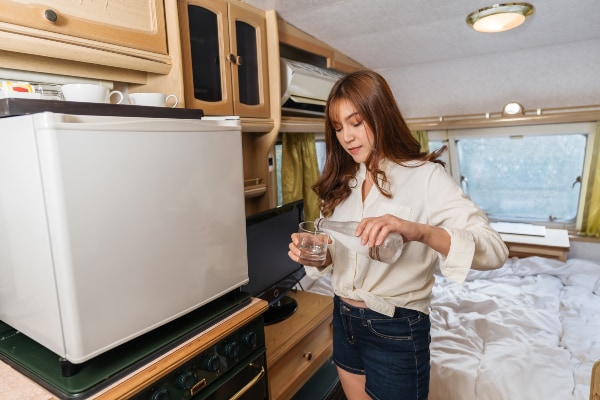
Almost every caravan or motorhome has a built-in fridge.
A cool box for at the campsite
Many campsites have a communal fridge and/or freezer that you can use (for a charge). This is very common at many small campsites and farm campsites. Would you like to have more room? There are many campsites where you can rent a private fridge for your pitch. This is great if you are camping with a tent or trailer tent. Do you have your own cool box with cooling elements? Make sure you take along enough elements to be able to exchange them and enjoy cold products continuously. A handy service that many campsites offer is that you can freeze your cooling elements in the campsite’s freezer or freezing compartment.
Shop more often
This may be rather obvious but, if you do not have a fridge available, it is a good idea to go shopping more often. Although you might shop twice a week at home, this may not always work at the campsite. In addition, food does not stay good for as long without proper cooling agents. With meat and dairy products, it is especially handy to purchase smaller portions more often.
More cooling tips?
Do you have your own handy tips for keeping food and drink cold while on holiday? Let us know by leaving a comment.


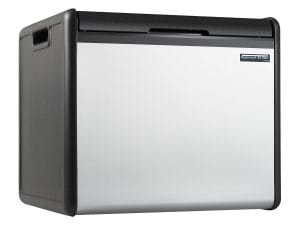
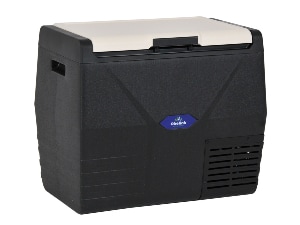
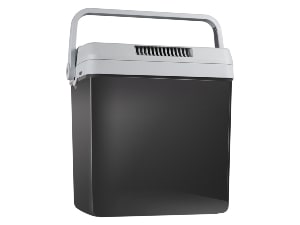
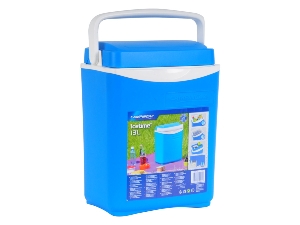








Latest comments